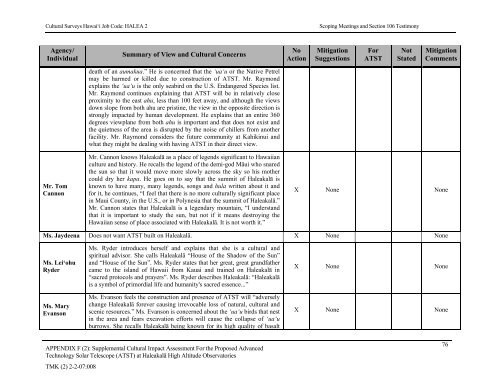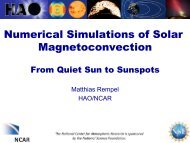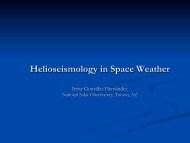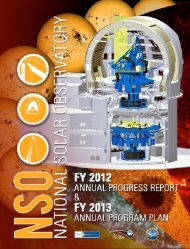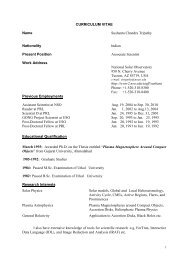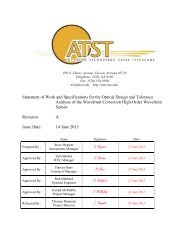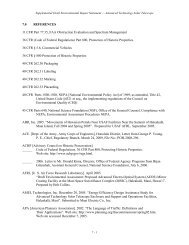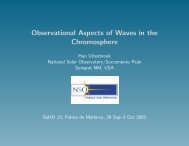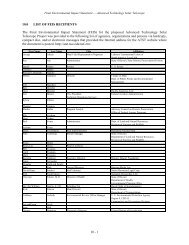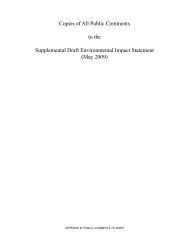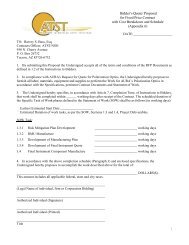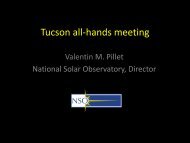F2 - ATST
F2 - ATST
F2 - ATST
Create successful ePaper yourself
Turn your PDF publications into a flip-book with our unique Google optimized e-Paper software.
Cultural Surveys Hawai‘i Job Code: HALEA 2 Scoping Meetings and Section 106 TestimonyAgency/IndividualSummary of View and Cultural ConcernsNoActionMitigationSuggestionsFor<strong>ATST</strong>NotStatedMitigationCommentsdeath of an aumakua.” He is concerned that the ‘ua‘u or the Native Petrelmay be harmed or killed due to construction of <strong>ATST</strong>. Mr. Raymondexplains the ‘ua‘u is the only seabird on the U.S. Endangered Species list.Mr. Raymond continues explaining that <strong>ATST</strong> will be in relatively closeproximity to the east ahu, less than 100 feet away, and although the viewsdown slope from both ahu are pristine, the view in the opposite direction isstrongly impacted by human development. He explains that an entire 360degrees viewplane from both ahu is important and that does not exist andthe quietness of the area is disrupted by the noise of chillers from anotherfacility. Mr. Raymond considers the future community at Kahikinui andwhat they might be dealing with having <strong>ATST</strong> in their direct view.Mr. TomCannonMr. Cannon knows Haleakalā as a place of legends significant to Hawaiianculture and history. He recalls the legend of the demi-god Māui who snaredthe sun so that it would move more slowly across the sky so his mothercould dry her kapa. He goes on to say that the summit of Haleakalā isknown to have many, many legends, songs and hula written about it andfor it, he continues, “I feel that there is no more culturally significant placein Maui County, in the U.S., or in Polynesia that the summit of Haleakalā.”Mr. Cannon states that Haleakalā is a legendary mountain, “I understandthat it is important to study the sun, but not if it means destroying theHawaiian sense of place associated with Haleakalā. It is not worth it.”XNoneNoneMs. Jaydeena Does not want <strong>ATST</strong> built on Haleakalā.X None NoneMs. Lei‘ohuRyderMs. Ryder introduces herself and explains that she is a cultural andspiritual advisor. She calls Haleakalā “House of the Shadow of the Sun”and “House of the Sun”. Ms. Ryder states that her great, great grandfathercame to the island of Hawaii from Kauai and trained on Haleakalā in“sacred protocols and prayers”. Ms. Ryder describes Haleakalā: “Haleakalāis a symbol of primordial life and humanity's sacred essence...”XNoneNoneMs. MaryEvansonMs. Evanson feels the construction and presence of <strong>ATST</strong> will “adverselychange Haleakalā forever causing irrevocable loss of natural, cultural andscenic resources.” Ms. Evanson is concerned about the ‘ua‘u birds that nestin the area and fears excavation efforts will cause the collapse of ‘ua‘uburrows. She recalls Haleakalā being known for its high quality of basaltXNoneNoneAPPENDIX F (2): Supplemental Cultural Impact Assessment For the Proposed AdvancedTechnology Solar Telescope (<strong>ATST</strong>) at Haleakalā High Altitude ObservatoriesTMK (2) 2-2-07:00876


